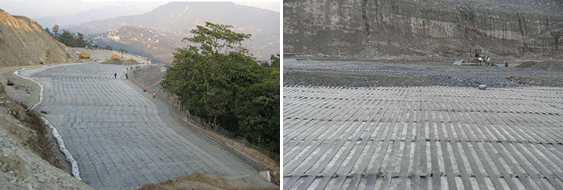The 74m-high reinforced soil structure at the Sikkim Airport (India) is one of the largest geosynthic megastructure projects in the world. The 50m-high reinforced, vegetated wall at the Shennongjia Airport in Hubei Province (China) is another. Both projects have been engineered with Maccaferri soil reinforcement solutions.
MAKING MEGASTRUCTURE DESIGNS POSSIBLE
High-performance geogrids reinforce soils, which allow for steeper grades and higher loads. Megastructure projects have benefited tremendously from the geosynthetic reinforcement technology. These designs have made such structures far more economical and have shown less settling, thus enabling the full system to provide long-term service lives.
For Maccaferri, the approach has been to combine retaining walls, geogrid soil reinforcement, and other geotechnical components (e.g., wire mesh fascia) to create scalable, optimally performing designs with well understood installation methodologies.
RELATED: Seismic Behavior of Hybrid Reinforced Soil High Walls and Slopes
STRENGTH IN UNITY: SIKKIM AIRPORT
The Sikkim Airport in India’s massive 74m-high reinforced soil structure, built in 2013, has rightfully garnered international recognition and awards. It has also raised awareness of the scale these structures may safely be built at with the right reinforcement materials and techniques.
The mountainous terrain in Sikkim was challenging enough for runway construction, but it was also an area with a high annual rainfall. Once the site was cleared and slopes were cut and filled, a retaining wall system was needed to prevent erosion.
A Paramesh System was specified. The system had two material components: Terramesh® / Green Terramesh® and ParaLink® high-performance geogrids. The Paralink® geogrids provided the primary reinforcement for the high loads on the system. Terramesh® and Green Terramesh®, meanwhile, provided a modular system that was designed for this type of rock-faced mechanically stabilized earth (MSE) wall/embankment.

Geogrids installation at Sikkim airport project. Photo by Maccaferri.
The system utilized pre-assembled units of double-twisted wire mesh (8×10 type). The facing section of the unit was formed by connecting a back panel and diaphragms to the main fascia unit, thus creating rectangular shaped cells for stone confinement. The geogrid reinforcement, fascia, and lid were all one continuous panel of mesh.
Following assembly on site, the fascia unit was filled with suitable gabion stone fill. Structural backfill was then placed upon the soil reinforcement geogrids and compacted. Subsequent Terramesh® layers were placed onto the completed layer beneath.
This approach accelerated construction and enabled the promotion of vegetation re-establishment, which helped further stabilize the slopes while blending with the surroundings.
REDUCING ENVIRONMENTAL IMPACT: SHENNONGJIA AIRPORT
For the new airport in Shennongjia, the megastructure works needed to be conducted alongside the Shennongjia Nature Reserve. This location presented accessibility limitations and a high degree of caution on impairing the natural beauty.
A cut-and-fill operation was decided upon. This approach enabled the insertion of the 2,800m runway and airport buildings. To stabilize and reinforce the ‘fill’ (valley) side of the project, soil reinforcement offered the most effective solution:
- Use of the ‘cut’ waste material as structural backfill within the soil reinforcement ‘fill’ walls would minimize the export/import of construction materials
- It would minimize the footprint of the solution compared to traditional earthworks
- It would be more cost-effective and offer a lower carbon footprint than a comparable height traditional retaining structure
- It would be a flexible system, thus able to accommodate differential settlements and remove the need for a rigid foundation structure
Engineers used a Terramesh® system (secondary reinforcement) and MacGrid WG® geogrids (primary reinforcement) to build the subsequent 50m reinforced soil wall.

Shennongjia MSE wall. Photo by Maccaferri.
The high-strength primary reinforcement layer utilized geogrids with polyester fibres encased within a polymer sheathing for enhanced environmental protection. The modular Terramesh® system enabled the entire structure to become covered in vegetation.
The hybrid MSE approach met both long-term performance and environmental goals.











